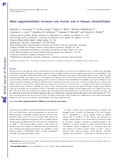Meat supplementation increases arm muscle area in Kenyan schoolchildren.
Date
2013Author
Neumann, CG
Jiang, L
Weiss, RE
Grillenberger, M
Gewa, CA
Siekmann, JH
Murphy, SP
Bwibo, NO
Type
ArticleLanguage
enMetadata
Show full item recordAbstract
The present study examines the effect of animal-source-food (ASF) intake on arm muscle area growth as part of a larger study examining causal links between ASF intake, growth rate, physical activity, cognitive function and micronutrient status in Kenyan schoolchildren. This randomised, controlled feeding intervention study was designed with three isoenergetic feeding interventions of meat, milk, and plain traditional vegetable stew (githeri), and a control group receiving no snack. A total of twelve elementary schools were randomly assigned to interventions, with three schools per group, and two cohorts of 518 and 392 schoolchildren were enrolled 1 year apart. Children in each cohort were given feedings at school and studied for three school terms per year over 2 years, a total of 9 months per year: cohort I from 1998 to 2000 and cohort II from 1999 to 2001. Food intake was assessed by 24 h recall every 1–2 months and biochemical analysis for micronutrient status conducted annually (in cohort I only). Anthropometric measurements included height, weight, triceps skinfold (TSF) and mid-upper-arm circumference (MUAC). Mid-upper-arm muscle area (MAMA) and mid-upper-arm fat area (MAFA) were calculated. The two cohorts were combined for analyses. The meat group showed the steepest rates of gain in MUAC and MAMA over time, and the milk group showed the next largest significant MUAC and MAMA gain compared with the plain githeri and control groups (P< 0·05). The meat group showed the least increase in TSF and MAFA of all groups. These findings have implications for increasing micronutrient intake and lean body mass in primary schoolchildren consuming vegetarian diets
URI
http://www.ncbi.nlm.nih.gov/pubmed/22856533http://erepository.uonbi.ac.ke:8080/xmlui/handle/123456789/15923
Citation
Br J Nutr. 2013 Apr;109(7):1230-40.Publisher
Fielding School of Public Health, University of California at Los Angeles, Los Angeles, CA, USA Department of Paediatrics and Child Health, University of Nairobi University of Hawai'i at Manoa, Honolulu, HI, USA David Geffen School of Medicine, University of California at Los Angeles, Los Angeles, CA, USA School of Rural Public Health, College Station, TX, USA Max Rubner-Institut, Federal Research Institute of Nutrition and Food, Karlsruhe, Germany College of Health and Human Services, George Mason University, Fairfax, VA, USA
Collections
- Faculty of Health Sciences (FHS) [10387]

